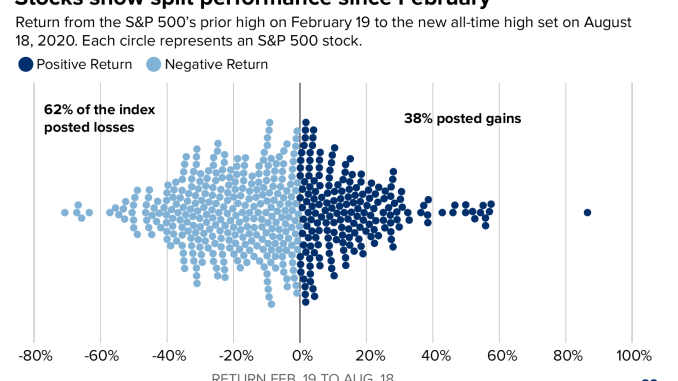
The S&P 500 closed at a record high on Tuesday, wiping out losses from the coronavirus-induced sell-off and returning the market to pre-pandemic levels.
But while the index is right back where it started before the virus sent the market plunging, a CNBC analysis shows that the majority of stocks have yet to climb back to their prior levels. While the overall market crashed and then reached new heights between its previous high on Feb. 19 and new high on Aug. 18, only 38% of stocks in the index made gains over that time period. A majority, the remaining 62%, were negative.

In many cases, these still-reeling stocks are down significantly from where they were in February. While there have been a number of big winners — 43 stocks in total saw gains of 25% or more, including health care and technology names like ABIOMED (87%), PayPal (57%), and Amazon (53%) — there have been far more big losers.
A quarter of the index, 126 stocks in total, saw declines of 25% or more compared to the Feb. 19 starting point. Norwegian Cruise Lines (-71%), Occidental Petroleum (-67%), and Carnival Corporation (-67%) are the top three laggards over the period.
In an interview on CNBC following Tuesday’s record close, Michael Yoshikami, CEO of Destination Wealth Management, described a “shift in demand” that explains why stocks haven’t moved in unison since the market’s last record.
“It’s not as if everything is rising,” he said. “You pull money out of names that really aren’t attractive given current conditions. And that money moves over to companies that are thriving in this environment.”
As Yoshikami described, stocks in some sectors have fared better than others. In consumer staples, health care, and information technology, more than 50% of stocks posted gains between Feb. 19 and Aug. 18. In energy and utilities, however, less than 10% did so.
But even within individual sectors, performance has not been uniform. Tech stocks, for example, which rose 12% from prior high to new high and are an oft-cited explanation for the stock market’s incredible comeback, saw wide-ranging performance. On one end of the spectrum, PayPal and Nvidia each rose by more than 50%, while on the other end Western Digital and Xerox both fell just as steeply.
In the health care sector, performance varied just as widely. Abiomed led all stocks in the index with an 87% gain from Feb. 19 to Aug. 18, and West Pharmaceuticals and Regeneron, at 58% and 54%, were also among the top performers. But more than 40% of stocks in the sector were down, including Dentsply Sirona (-26%), Universal Health Services (-19%), and Cigna (-18%).
The one area in which stocks have shown alignment is throughout the market’s return from the S&P 500′s March 23 low point, when the index rose by 52% en route to the new record high. Over that surge, just six stocks — Coty Inc., FirstEnergy, Walgreens, Gilead Sciences, Wells Fargo, and Intel — were negative.
*story by CNBC